When Can I Put My Baby In A Forward Facing Car Seat
The nation'southward superlative scientists, researchers, and physicians recommend that kids sit rear-facing in the automobile for as long as possible, because rear-facing is safer. Here's why your ii, 3, 4 or even 5 twelvemonth one-time should exist riding rear-facing.
The American University of Pediatrics (AAP) has for 20+ years recommended keeping kids rear-facing until they are also large for rear-facing in their convertible seat. The AAP reiterated this in their 2018 policy statement.
The National Highway Traffic Safe Administration (NHTSA) also updated their recommendations, at present specifying that children remain rear-facing until reaching "the tiptop elevation or weight limit allowed past your car seat'south manufacturer."
The primary questions nosotros get concerning extended rear-facing have to do with WHY information technology's safer, and HOW bigger kids can stay comfortable rear-facing (jump in that location now). Information technology'south a big topic but nosotros've tried to address it clearly and thoroughly hither. Delight permit united states know if you have questions about this disquisitional safe issue!
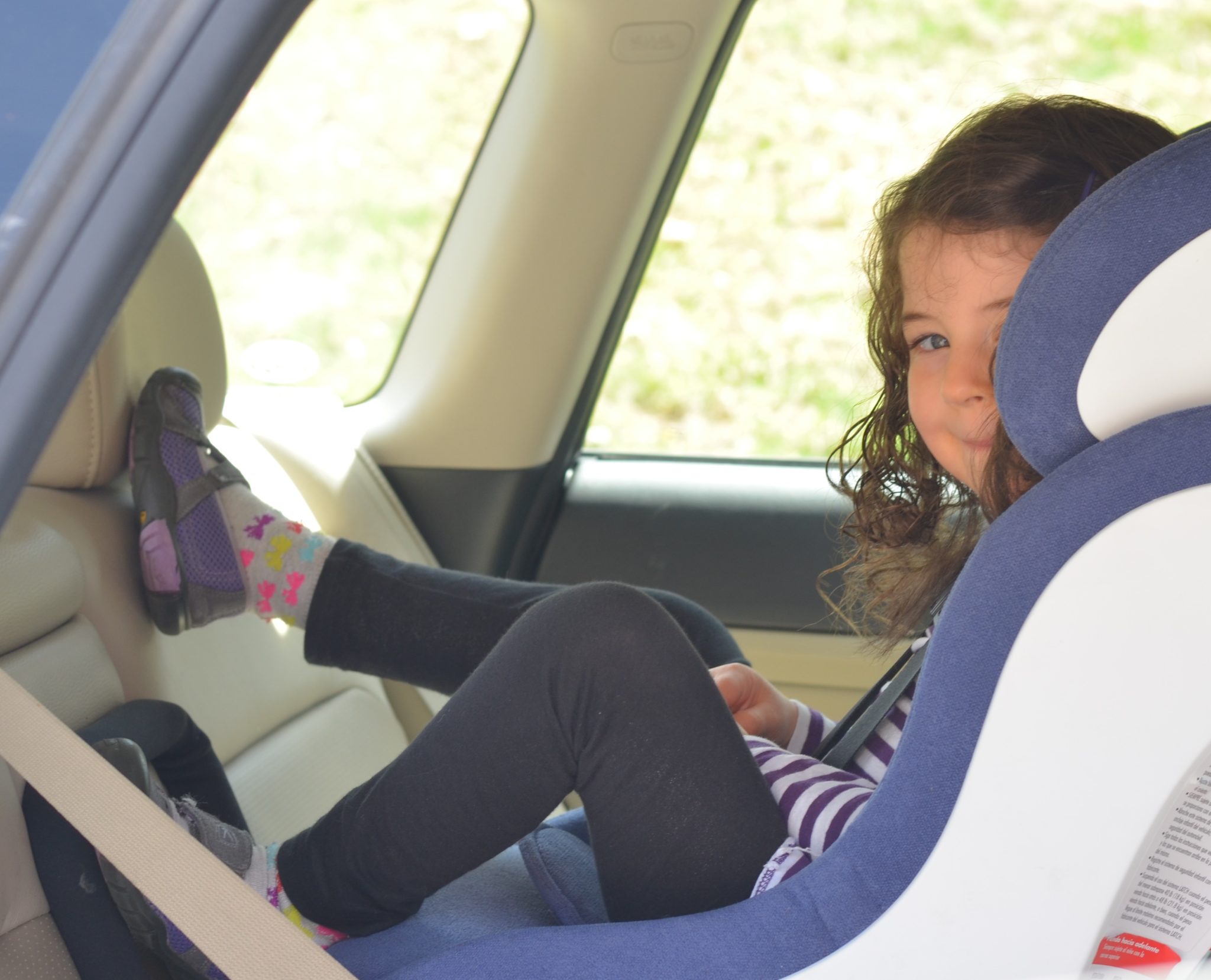
Rear-facing: Non Just for Babies
Why 2, 3, 4, and even 5 year olds should be rear-facing!
The American Academy of Pediatrics (AAP) has for 20+ years recommended keeping kids rear-facing until they are also big for rear-facing in their convertible seat. This was reiterated in their 2018 policy statement.
The National Highway Traffic Rubber Administration (NHTSA) also updated their recommendations, at present specifying that children remain rear-facing until reaching "the top height or weight limit allowed by your auto seat'southward manufacturer."
Our Favorite Seats for
Keeping Big Kids Rear-facing
Clek FoonfSplurge-worthy, high capacity rear-facing seat with max rubber features: anti-rebound bar and rear-facing tether. Optimized for installation on side seats. Narrow exterior and wide interior gives child max room while taking upwards less room in motorcar than many babe seats. Also has max safe features for forward-facing: rigid LATCH + crumple zone.Buy HereClek FlloHigh capacity rear-facing seat with max prophylactic features: anti-rebound bar and rear-facing tether. Optimized for installation in middle seat. Narrow exterior and broad interior gives child max room. Slap-up in 3-across when RF in center seat.Purchase HereGraco Extend2FitHighest rear-facing chapters of any seat in US for both tallest and heaviest kids. Fits well in small cars behind tall drivers while giving child lots of leg room. Budget friendly! Note: we do not recommend the Platinum or 4Ever models – nosotros like the bones 2-in-1 model best!Buy Here
Previous
Next
15 states at present require kids to remain rear-facing until at least their 2nd birthday.
Whoa… yous might be thinking "how does a ii-year-onetime fit rear-facing"… take 90 seconds and watch the following video – and you lot'll encounter how these 90 different 2 year olds all ride safely and comfortably rear-facing.
Common Questions well-nigh Rear-facing
Why is rear-facing safer than forwards-facing?
Instead of having your head pull violently away from your chest, as happens when yous are forward-facing in a frontal crash, the rear-facing kid is cradled in their seat in much the aforementioned style equally you catch a fastball in a manus.
This video shows two 12-month-erstwhile crash test dummies each secured in the aforementioned motorcar seat but one is rear-facing and i is forward-facing – watch how much the forrard-facing dummy'south head and neck motion – and call back that this video is slowed downward tremendously as crashes happen quicker than the blink of an eye. For more on the physics behind why rear-facing is safer, encounter here.
What nigh their legs? Isn't it unsafe and/or uncomfortable?
The video in a higher place shows a side by side comparison of a frontwards-facing car seat (on the left) and a rear-facing car seat (on the right) using the same crash test dummy and the same crash speed.
Discover how the rear-facing dummy tucks into a cannonball position? No matter how scrunched the rear-facing child's legs start, they end upward super scrunched during the crash and it does NOT cause injury to the legs (or other parts of the body either).In that location are ZERO documented cases of rear-facing children breaking their legs, hips, feet, etc., due to their feet touching the back of the vehicle seat. In fact, studies show that forrard-facing kids suffer many more leg injuries than rear-facing kids. The leg injuries to forward-facing children occur when the kid's legs wing up and hit the back of the front seat all the while the kid & machine seat are moving frontward which traps the child'southward legs and puts tremendous pressure into the leg basic which tin break them.
What you should be asking is "What about the HEAD & Cervix?" – find how the forward-facing kid'south head and neck are thrown forward (snug straps only hold the breast back, not the caput & cervix) – whereas the rear-facing kid'southward head and neck are cradled within the beat out of the automobile seat. The forrard-facing kid'southward head being thrown violently forward IS a cause for brain and spinal cord injury… injury we can prevent past keeping a kid rear-facing.
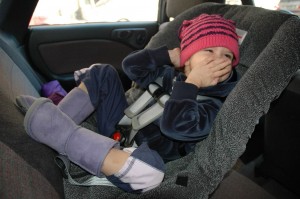
3-year-old happily rear-facing
Besides worrying about leg injuries, many parents worry virtually leg discomfort in the rear-facing kid. As kids go older, their feet will touch the dorsum of the vehicle seat; this is both comfy and safe. Ever wonder why a 5-year-sometime can sleep comfortably with his chin on his chest and never wake upwardly complaining of a strong neck? Information technology's considering kids' joints aren't fully formed, which lets them sit comfortably in positions that would be painful for even a yoga main. Kids have much more than flexibility and range of motion in their talocrural joint, knee and hip joints than nosotros exercise. For this reason, a 3-year-old can sit comfortably rear-facing with her legs crossed or in the "frog leg" position.
Parents of forward-facing children will know that the kids often endeavour and put their feet up wherever they can – ofttimes the dorsum of the front seat (which drives many adults crazy!). Forward-facing kids are doing this as merely like you lot aren't comfortable when y'all sit on a bar stool without a human foot balance and your legs are left to dangle, they don't like their legs dangling in the car seat equally happens forrad-facing (but doesn't happen rear-facing).
What about rear-facing in a rear-end crash?
A recent study looked at rear-facing auto seats in rear impacts. They report found that rear-facing motorcar seats mitigate and manage crash forces in a variety of ways that let them to provide good protection for rear-facing kids. This finding is backed upward by epidemiological and field data which also evidence that real kids riding rear-facing in real rear-stop crashes typically do very well.
Someone told me I can turn my child forward-facing at 1 year and 20 pounds. Is this right?
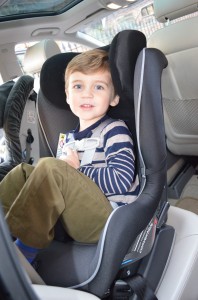
This is NOT correct. Many years ago, in the days before the iPhone was invented, the minimum to turn forward facing was 1 twelvemonth and 20 pounds.
In 2011 both the AAP and NHTSA updated their recommendations to reflect the latest research in kid passenger safety. The AAP now recommends that kids sit down rear-facing until at least age 2. NHTSA now recommends: "Your child should remain in a rear-facing car seat until he or she reaches the top tiptop or weight limit allowed by your car seat's manufacturer."
But my child'southward convertible car seat merely goes to 20 or 22 pounds rear-facing. What exercise I do?
Our government requires manufacturers to include some exceptionally confusing wording on the labels of every convertible car seat (car seats that commencement out rear-facing & and then go forward-facing). The sentence that confuses most is "Utilize but in a rear-facing position when using it with an infant weighing less than 20 lbs." What this sentence is trying to say, is that for kids who weigh less than xx lbs. the only direction you lot are allowed to install this automobile seat is rear-facing – i.e. a child nether 20 pounds may never ride forward-facing in this car seat. However, many people confuse this to hateful that after 20 pounds you lot must turn the car seat forward-facing – which is Non what it is trying to say. In another sentence, probable very close to where you found the confusing ane, information technology will give the rear-facing minimum and maximum weights for your convertible seat. All convertible seats on the marketplace in the US for many years now go rear-facing until at least 30 pounds, with most going to 40 or more pounds rear-facing.
When is a child TOO BIG for rear-facing?
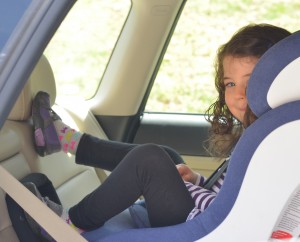 A child can be either likewise heavy, too tall, or both–simply all of this depends on the specifcations of the machine seat. Each machine seat has its own pinnacle and weight limits for rear-facing children. Most convertible seats allow children to sit rear-facing upward to 35, 40 or 50 pounds. The peak limit for nearly rear-facing car seats is that there must be at to the lowest degree 1 inch of room between the superlative of the child'due south head and the top of the car seat. This inch ensures that equally the child slides upwardly the seat in a crash, his head will stay protected. Given the design of virtually car seats, the majority of children get too alpine for rear-facing seats before they become too heavy. Therefore, when you purchase a convertible car seat, endeavour to select 1 that is taller in seated height.
A child can be either likewise heavy, too tall, or both–simply all of this depends on the specifcations of the machine seat. Each machine seat has its own pinnacle and weight limits for rear-facing children. Most convertible seats allow children to sit rear-facing upward to 35, 40 or 50 pounds. The peak limit for nearly rear-facing car seats is that there must be at to the lowest degree 1 inch of room between the superlative of the child'due south head and the top of the car seat. This inch ensures that equally the child slides upwardly the seat in a crash, his head will stay protected. Given the design of virtually car seats, the majority of children get too alpine for rear-facing seats before they become too heavy. Therefore, when you purchase a convertible car seat, endeavour to select 1 that is taller in seated height.
What well-nigh big kids – those who are "off the charts"?
A 95th percentile child may look stronger than his 5th percentile friend, but in a crash the bigger child is More at hazard if he's riding forrad-facing. The rigidity of basic and the strength of ligaments in the spine is likely the same in children of the same age, no matter their size. And a 95th percentile baby likely has a much larger, heavier head, which will pull forrard which much more force than that of a 5th percentile child. Click here to learn about seats that can best accommodate the biggest kids rear-facing.
What if my child is unhappy riding rear-facing?
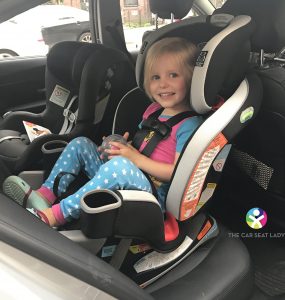
Rear-facing does non accept to be boring! Older kids can ride quite upright so they can see out the side and rear windows. If there is a head rest blocking your child's view out the back window, you can usually remove information technology. By 9-12 months your infant knows you're there when you talk to them from the front – fifty-fifty though they tin can't run into y'all. So you can calm and entertain your child with songs, stories – and for older children games of "I spy" – all while they are rear-facing.
Nosotros've got lots of suggestions for great automobile seat & travel toys for babies & toddlers (and large kids likewise) – check them out here – because sometimes we all become a little cranky when we're bored!
What are some good toys for rear-facing kiddos?
Nosotros've got a pediatrician-curated selection of toys, teethers, and games that are automobile seat & travel friendly for babies, toddlers & big kids. We all go a trivial cranky when nosotros're bored – and these are sure to keep boredom at bay!
What well-nigh kids who become movement sick?
The long and brusk: nearly kids practice not puke less when forward-facing compared to rear-facing.
We've got lots of information on motion-sickness over here – including an explanation of why it is believed to occur, things you can do to decrease the hazard of your kid puking, and how to minimize the mess and clean upward if your kid does puke.
I already turned my ane year old forward-facing – should I really turn her dorsum rear-facing?

Aye! When we know better, we must do better. Iii months ago when you lot turned her forward facing you did what you thought was best, simply now you lot know differently. Avoid regrets, and give her the best protection.
Many parents worry that it will be a disaster turning an older kid back rear-facing. Here is one mom's experience turning her almost-3-year-sometime son back rear-facing:
"I was initially very hesitant to movement my almost iii year quondam son to rear facing from forward facing. He has been sitting forward facing for over a year and can be strong willed when it comes to change. Nevertheless, after hearing how much safer it is I was willing to try. The first iii or so drives were very hard equally he asked to "await out mama and dada's window" almost the unabridged time. We ignored and distracted and I was about to give upward when I noticed that although he nevertheless complained about sitting rear facing it happened less and less. Now (later about three weeks) he asks maybe in one case every other bulldoze if he can sit frontward facing and was even (more often than not) fine the other day when his friend joined usa and saturday forward facing. It was a tough offset few drives, just I am very happy nosotros did it and I experience and then much safer.
I already turned my 1 year old forrard-facing – should I actually turn her back rear-facing?

Yes! When we know better, we must do improve. Three months agone when you turned her forrard facing you did what you idea was best, just now you know differently. Avoid regrets, and requite her the best protection.
Many parents worry that it will exist a disaster turning an older kid back rear-facing. Here is ane mom's experience turning her well-nigh-3-twelvemonth-former son back rear-facing:
"I was initially very hesitant to move my nearly three year old son to rear facing from forwards facing. He has been sitting forward facing for over a yr and can be strong willed when it comes to modify. However, afterwards hearing how much safer it is I was willing to try. The commencement three or and so drives were very difficult every bit he asked to "look out mama and dada'south window" well-nigh the entire time. We ignored and distracted and I was well-nigh to give up when I noticed that although he all the same complained about sitting rear facing it happened less and less. At present (later on virtually three weeks) he asks perchance once every other bulldoze if he can sit forrard facing and was even (generally) fine the other solar day when his friend joined the states and sat frontwards facing. It was a tough first few drives, only I am very happy we did it and I feel and so much safer.
My 20-month-old is too heavy for rear-facing in his current seat – should I really buy a unlike seat and then he can ride rear-facing longer?
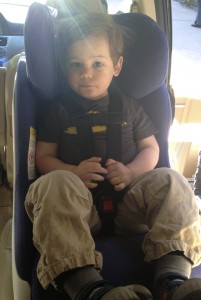
Imagine it's November and your 20-month-old has outgrown all of her winter clothes from last twelvemonth. Would yous non purchase her new wintertime clothes considering "it will be warmer in four months"? The machine seat is one of the just products you volition always buy for your child that has the potential to save her life! Just like your kid needs new clothes often, they may need a new car seat sooner than you thought. If you are in a crash, you volition be relieved knowing that yous gave her the best protection possible.
What is the police force?
The laws of physics don't care about the laws of the state… only with that said, information technology is now law in 15 states that children ride rear-facing until at least age 2.
- California
- Connecticut
- Illinois
- Louisiana
- Maine
- Nebraska
- New Jersey
- New York
- Oklahoma
- Oregon
- Pennsylvania
- Rhode Island
- South Carolina
- Virginia
- Washington
What is the evidence?
It is critically of import to understand that the recommendation to keep children under age ii rear-facing is non based on a unmarried written report, but rather on a broad body of enquiry from the U.s.a. and Sweden. These citations are included below for easy reference.
- Sherwood CP, Crandall JR. Frontal sled tests comparing rear and forwards facing kid restraints with 1-3 year old dummies.Annual Proceedings of the Clan for the Advancement of Automotive Medicine. Association for the Advancement of Automotive Medicine, 2007,51: 169-80.
- Planath I, Rygaard C, Nilsson S. Synthesis of data towards neck protection criteria for children.Proceedings of the 1992 International IRCOBI Conference on the Biomechanics of Impacts. Verona, Italia:155-66.
- Kamren B, Koch Chiliad, Kullgren A, et al. The protective furnishings of rearward facing CRS: an overview of possibilities and problems associated with child restraints for children aged 0-three years.Child Occupant Protection Symposium: SAE International, 1993.
- Klinich KD, Manary MA, Weber KB. Crash protection for child passengers: rationale for best do.UMTRI Res Rev 2012;43:1-35.
- Isaksson-Hellman I, Jakobsson L, Gustafsson C, et al. Trends and furnishings of child restraint systems based on Volvo's Swedish accident database.41st Stapp Motorcar Crash Conference: SAE International, 1997.
- Jakobsson L, Isaksson-Hellman I, Lundell B. Safety for the growing child: experiences from Swedish accident information.Proceedings of the 17th ESV Conference, 2005.
- American Academy of Pediatrics, Committee on Injury, Violence & Poison Prevention. Child Rider Prophylactic. Pediatrics. 2018.
- Arbogast KB, et al. Injuries to Children in Forward Facing Child Restraints. Annual Proceedings Association for the Advancement of Automotive Medicine. 2002; 46: 213-30.
We are a reader supported site. Nosotros earn an chapter commission when you purchase through our links.
FTC Disclosure: Chapter links are included in this folio. No budgetary compensation was provided, however, some of the reviewed products were supplied past the manufacturer or benefactor to help facilitate the review. All opinions are those of The Automobile Seat Lady LLC.
Source: https://thecarseatlady.com/when-should-your-child-turn-forward-facing/
Posted by: mannpriage.blogspot.com


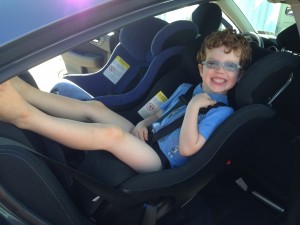

0 Response to "When Can I Put My Baby In A Forward Facing Car Seat"
Post a Comment